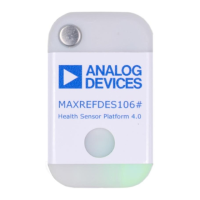©2023 Analog Devices, Inc. All rights reserved.
MAXREFDES106# Health Sensor Platform 4.0
Selects the internal lead biasing resistors. These are
selectable resistors connected between the ECGP/ECGN
input pins and V
MID_ECG
that drive the electrodes within the
input common-mode requirements of the ECG channel and
can drive the connected body to the proper common-mode
voltage level. For dry electrode use cases, where contact
impedances can be much higher and potentially
imbalanced, the use of a third electrode (RLD) is strongly
advised instead of internal lead biasing.
Positive Input
Bias Enable
Enables/Disables the connection of the lead bias resistor to
the ECGP source.
Negative Input
Bias Enable
Enables/Disables the connection of the lead bias resistor to
the ECGN source.
Enables/Disables the connection of the calibration PWM
voltage signals to the ECGP/ECGN source. These
calibration signals are available to provide rectangular
pulse-train signals for internal signal-chain validation.
Selects the voltage source to use for calibration of the
ECGP channel. Each input can be connected to either of
the two sources or V
MID_ECG
for differential mode amplitudes
between 0.25mV
PP
and 2.0mV
PP
or common-mode
amplitudes between 0.25mV
PP
and 1mV
PP
.
Sets the calibration voltage source for both ECGP and
ECGN sources to be unipolar or bipolar with respect to
V
MID_ECG
.
Sets the amplitude of the calibration PWM signals.
Sets the frequency of the calibration PWM signals.
Sets the pulse-width of the calibration PWM signals.
ECG Lead OFF Tab
This tab offers an expanded view of the ‘ECG Lead Off’ block in the ‘ECG Mux’ tab and is used to
configure AC or DC lead-off detection. Lead-off detection is used to detect when the ECG electrodes are
no longer in contact with the skin, or the electrode has deteriorated, resulting in a high electrode
impedance. AC and DC leads off can be used while the ECG cannel is enabled.
Fundamentally, these lead-off detection methods involve sinking and sourcing current into the
ECGP/ECGN lines and checking for a conduction path through the body by measuring differential voltage
(DC) or impedance (AC). Refer to the MAX86178 data sheet for more details, and the available options in
Table 9 for more details on the available configurations.

